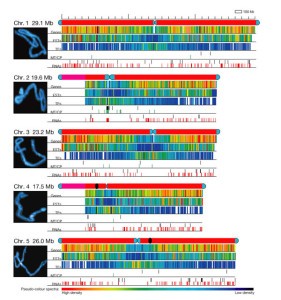From the Human Genome Project to plant breeding, genomic research is here to stay
The desire to know more about how genomes work has attracted thousands of researchers as well as billions of investment dollars. Advances in computers, biology and information sharing have revolutionized how plant breeding is now done.

Source: Analysis of the genome sequence of the flowering plant Arabidopsis thaliana, Journal of Nature, December 14, 2000
As a point of reference, consider the following.
- The Human Genome Project which sequenced the human genome over a 10 year period, from 1990-2000, included thousands of people, at a cost of about $1 billion.
- In 2000, 500 people over 7 years at a cost of $70 million sequenced the genome of arabidopsis, an oilseed plant which is commonly used to model proof of genomic breeding techniques.
- By 2012, it takes only one person, 2-3 minutes at a cost of $99 to sequence arabidopsis.
Today, you could spend $700 and have your own genome sequenced in 7 hours. Just think of it, what took an entire decade and a billion dollars, can now, 15 years later, be done in a day for a few hundred bucks. The ability to generate knowledge about genomes has never been greater. This abundance of genomic knowledge has allowed plant breeders to better understand what each gene controls, how the level of expressions can be increased or decreased and how the gene can be transferred to other plants.
Many opponents of modern plant breeding frequently argue that plant breeding needs to return to using conventional plant breeding methods, such as transferring pollen from one flower to another. Plant breeding using this method transfers anywhere from 10,000 to 300,000 genes between the two plants. Modern plant breeding is capable of transferring a single gene.
Previously, if plant breeders wanted to develop a new variety that was resistant to say, a new plant disease, they would search fields for plants that had a natural resistance to the new disease and then cross this plant with others to hopefully transfer the trait for disease resistance. Some of the resulting plants would have this trait, while others would not. All of this takes considerable time and effort.
With plant genomes being increasingly sequenced and with a greater understanding of what specific genes are responsible for in the plant, plant breeders are able to use these new techniques to substantially reduce the time required to develop new varieties. To develop a new variety that has increased disease resistance, a gene from one variety of the species that has a high level of resistance can be transferred to other varieties of the species, guaranteeing the trait will be there in subsequent varieties.
These new plant breeding technologies are simply an extension of the digital knowledge and communication world we live in. As plant breeder knowledge continues to increase, the potential to make substantial advances in improving the yields, resistance and nutrition of plants also increases. It is through the use of these new innovative technologies for breeding new plant varieties, that humanity will be able to feed a planet of 9, 10 or 11 billion people.

